|
|
 |
|
Calanoida ( Order ) |
|
|
|
Diaptomoidea ( Superfamily ) |
|
|
|
Pontellidae ( Family ) |
|
|
|
Pontella ( Genus ) |
|
|
| |
Pontella sinica Chen & Zhang, 1965 (F,M) | |
| | | | | | | Syn.: | Pontella princeps Sewell, 1932 (p.382, Fig.F, M: 127, a-d); Mulyadi, 2000 (p.191, fig.12: M); 2002 (p.107, figs.M: 38a-h)
Pontella sewelli Heinrich, 1987 (p.932, figs.F, M); Mulyadi, 2011 (p.1519, figs.F, M: 4a-e, 5a-h) | | | | Ref.: | | | Chen & Zhang, 1965 (p.104, 127, Descr.F, figs.F); Zheng & al., 1982 (p.84, figs.F,M); Jeong & al., 2008 (p.96, Descr.M, figs.M,Rem.); Francis & Nishida, 2018 (p.442, Redescr. F, M, figs.F,M, molecular analysis, phylogeny; emendation) | 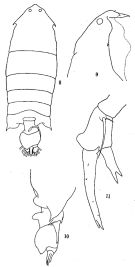 issued from: Q.-c Chen & S.-z. Zhang in Studia Marina Sinica, 1965, 7. [Pl.45, 8-11]. Questionable. Female (from E China Sea): 8, habitus (dorsal); 9, forehead (lateral); 10, Urosome (lateral left side); 11, left P5 (posterior). Nota: cephalothorax, broad, about 2.3 times as long as wide. - Frontal part of head conical with well-defined hooks. - Rostrum very large. - Postero-lateral angles of last thoracic segment, asymmetrical; right cone, shorter than the left, but its inner process coarser than that of the left side. - Urosome 3-segmented, asymmetrical; 1st segment with a large process on dorsal surface, its right edge with 3 spines, 3rd spine well-developed, terminal portion furcated, extending nearly to the end of 2nd segment, 2nd segment in dorsal view very large, oval, its left terminal margin with 2-3 denticles. - Anal segment very short, overlapped by preceding segment. - Furcal rami, broad, symmetrical, furcal setae coarse and short.
|
 issued from : Z. Zheng, S. Li, S.J. Li & B. Chen in Marine planktonic copepods in Chinese waters. Shanghai Sc. Techn. Press, 1982 [p.85, Fig.48]. Female: a, habitus (dorsal); b, forehead (lateral); c, urosome (dorsal); d, urosome (lateral, right side); idem (dorsal); f, P5. Male: g, habitus (dorsal); h-i, left P5 (distal part). Scale bars in mm.
|
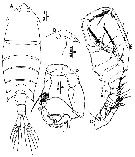 issued from : H.G. Jeong, H.-L. Suh, Y.H. Yoon, I.H. Choi & H.Y. Soh in Ocean Sc. J., 2008, 43 (2). [p.98, Fig.7]. Male (from SE Korea): A, habitus (dorsal); B, forehead (lateral, right side); C, right A1; D, P5. Nota: A1 geniculate, 15-segmented (segment XVI with elongated spine, segment XVII with triangular process, fused segments XIX and XX each with 1 large toothed plate, fused segments XXI to XXIII with 2 smaller toothed plates, proximal plate coarse and denticulated, distal one with villiform, and with 1 falcate process distally. Urosome 5-segmented. Genital segment slightly asymmetrical with lobe on left medially. caudal rami symmetrical.
|
 Issued from: Q.-c Chen & S.-z. Zhang in Studia Marina Sinica, 1965, 7. [p.128 ]. Comparison of distinguisehed features between P. sinica, P. atlantica, agassizii.
|
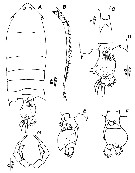 Issued from : S.V. Francis & S. Nishida in Crustaceana, 2018, 91 (4). [p.443, Fig.2] Female (froim 8°15'29''N, 73°0'36''E): Female: A, habitus (dorsal); B, right A1; C, rostrum (posterior view); D, urosome (dorsal); E, urosome (right lateral view); F, urosome (ventral view); G, P5 (posterior view). Arrows indicate 3 small processes located at even injtervals on left lateral margin of 2nd urosomal somite. Nota: - Forehead triangular with well-defined hooks. - Dorsal eye lens moderately developed, frontal, rostral and ventral absent. - Posterolateral angles of rostrum asymmetrical, right conical process shorter than left. - Head and 1st pediger, 4th and 5th pedigers separate. - Last thoracic segment asymmetrical with acuminate lobes, left lobe longer and wider than right. - Urosome asymmetrical with 3 somites; 1st somite with large dorsal process, complex scale-like structure on the dorso-medial surface, and 3 ventro-lateral processes on right side, of which middle one well developed, extending beyond middle of 2nd somite, while other processes much smaller; dorsal most process with bifurcated tip; 2nd urosomal somite oval with semi-circular dorsal process near posterior margin and 3 small processes located at even intervals on left lateral margin. Numerous dark coloured spots distributed over second urosomite. Distal end of 2nd urosomite extending to anal somite in dorsal and ventral position. - Anal somite short and asymmetrical. - Caudal rami broad and asymmetrical, right ramus larger than left. - A1 25 segments, extending beyond 4th pediger; first 9 segments rather smaller than others. - A2 to Mxp and 1st to 4th swimming legs similar to those of others species of the genus. - P5 symmetrical; basis with plumose seta and small seta on proximal posterior surface; exopod and endopod one-segmented with bifurcated tips; exopod with 3 minute outer marginal spines; endopod reaching half-length of exopod.
|
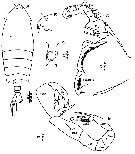 Issued from : S.V. Francis & S. Nishida in Crustaceana, 2018, 91 (4). [p.444, Fig.3] Male: A, habitus (dorsal); B, head (left lateral view); C, rostrum (posterior view, showing anterior and posterior lower frontal lenses in dotted and solid lines, respectively; D, right A1, number of segments indicated in Roman numerals; E, P5 (posterior view). Arrow indicates dorsal eye lenses. Abbreviations: Cox, coxa; Bas, basis; Exp1, 1st exopod; Exp2, 2nd exopod. - Forehead with prominent hooks.
- Posterior corners of prosome symmetrical and sharply pointed.
- Dorsal eye lenses larger than those of female; frontal lens absent; pair of anterior and posterior rostral lenses present. Rostal lenses oval in shape and asymmetrical.
- Urosome with 5 somites.
- Genital somite slightly asymmetrical with lobe-like projection.
- Caudal rami symmetrical.
- Right A1 geniculate. Ancestral segments I-II, IV-V, VIII-X, X-XII, XIII-XV totally or partially fused. Elongated spine present on segment VVI and a triangular process on segment XVII; segments XIX and XX each forming large, toothed plate, the latter with digitate process medially; 2 smaller coarse and toothed plates present on fused segments XXI-XXIII; digital margin with pointed triangular process. Segments XXIV-XXVIII completely fused.
- P5, right coxa and basis longer than left. Coxa bearing medial process on outer marginj. Each basis with long plumose seta and small seta. Right leg chelate, 1st exopodal segment with thumb-like process slightly curved in sigmoid manner, with small basal knob on inner-proximal margtinj, and semi-circular process with basal seta about midpoint of inner margin. 2nd exopodal segment with semi-circular inner-medial process, 3 setae, each on proximal, medial, and sub-distal points of inner margin, and seta on anterior surface near distal 1/3. Left leg, 1st exopodal segment with medial seta; 2nd exopodal segment with large and sub-basal spine extending beyond tip of exopod, with small seta near base. Segment ending in two unequal processes: longer process spatulate with crenulated margin and hirsute mediolaterally. Shorter process truncate distally and armed with short setae on apex, and 2 spines at base.
|
 Issued from : S.V. Francis & S. Nishida in Crustaceana, 2018, 91 (4). [p.447, Fig.4] Maximum likehood tree for P. sinica Chen & Zhang, 1965 and other Pontella species (taken from GenBank with their accession numbers) based on 100 bootstrap pseudoreplicates.
Authorities and dates of the species names mentioned in the figures are: P. spinipes Giesbrecht, 1889; P. rostraticauda Ohtsuka, Fleminger & Onbe, 1987, P. chierchiae Giesbrecht, 1889, P. fera Dana, 1849, Acartia negligens Dana, 1849.
|
 issued from : A.K. Heinrich in Zool. Zh., 1987, 66 (6). [p.933, Fig.1]. Female (from E Indian Ocean): 1, habitus (lateral right side); 2, idem (dorsal); 3, forehead (lateral); 4, rostrum; 5-7, urosome (dorsal, lateral right side, ventral, respectively); 8, urosomal processes (lateral right side); 9, P5. Scale bars: 1 mm. Nota: The obliquely cut distal margin of the 2nd abdominal segment pulled dorsally over the left caudal ramus is a specific feature of this species.
|
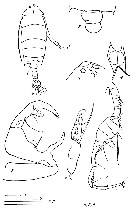 issued from : A.K. Heinrich in Zool. Zh., 1987, 66 (6). [p.934, Fig.2]. Male: 1, habitus (dorsal); 2, last thoracic sefment and urosomal segments 1 and 2; 3, forehead (lateral); 4, rostrum; 5, right P5; 6, left P5; 7, right A1. Scale bars: 1 mm.
|
 Issued from : R.B.S. Sewell in Mem. Indian Mus., 1932, X (continued). [p.383, Fig.127]. As Pontella princeps. Female (from Nicobar Is.): a, urosome; b, Mxp (terminal segments). Male: c, P5 (terminal segment); d, right P5.
|
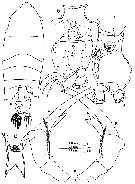 Issued from : Mulyadi in Crustaceana, 2011, 84 (12-13). [p.1520, Fig.4]; Female (from Sempu Island, E Java): a, habitus (dorsal); b, urosome (dorsal); c, same (ventral); d, rostrum (anterior view); e, P5 (posterior view; L = left leg, R = right leg)
|
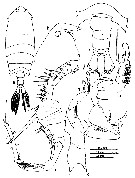 Issued from : Mulyadi in Crustaceana, 2011, 84 (12-13). [p.1521, Fig.5]; Male (from Sempu Island, E Java): a, habitus (dorsal); b, forehead (lateral); c, metasomal segment 5 and urosome (dorsal); d, right A1; e, rostrum (anterior view); f, right P5; g, left P5; h, distal segment of left P5.
|
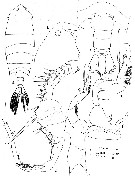 Issued from : Mulyadi in The Raffles Bull. Zool., 2000, 48 (2). [p.192, Fig.12]. Male (from Jakarta Bay): a, habitus (dorsal); b forehead (lateral); c, 5th metasomal somite and urosome (dorsal); d, right A1; e, rostrum (anterior view); f, right P5; g, left P5; h, distal segment of left P5. Nota: The male is identifiable by the very long outer spine-like process on distal segment of left P5, and the elongated spine on segment 14 of the right A1. After Jeong & al., 2008 b (p.97) the form described by Mulyadi as Pontella princeps is synonym of Pontella sinica
| | | | | Compl. Ref.: | | | Shih & Young, 1995 (p.72); Dur & al., 2007 (p.197, Table IV) | | | | NZ: | 3 | | |
|
Distribution map of Pontella sinica by geographical zones
|
| | | | | | | | |  issued from : H.G. Jeong, H-L. Suh, Y.H. Yoon, I.H. Choi & H.Y. Soh in Ocean Sc. J., 2008, 43 (2). [p.99, Fig.8]. issued from : H.G. Jeong, H-L. Suh, Y.H. Yoon, I.H. Choi & H.Y. Soh in Ocean Sc. J., 2008, 43 (2). [p.99, Fig.8].
Distribution of Pontella sinica based on previous records and present study. |
| | | | Loc: | | | Indian (E & W), E Java (Sempu Island), ? Indonesia-Malaysia (in A. Scott, 1909: as P. princeps); China Seas (East China Sea, South China Sea), Taiwan (SW), SE Korea, ? [ Bay of Bengal, S Sumatra-Java]
Type locality: 30°30' N, 123°15' E. | | | | N: | 15 | | | | Lg.: | | | (44) F: 5,87; M: 5,349; (290) F: 5,2; 5,25; ? (530) F: 5,2; M: 4,8; (900) M: 4,2-4,25; (1023) F: 5,19-5,85; M: 4,94-5,50; (1126) F: 5,45-5,50; M: 4,25-4,30; (1242) F: 5,2; M: 4,35, 4,47; {F: 5,20-5,87; M: 4,35-5,50} | | | | Rem.: | For Jeong & al. (2008, p.98) males most resemble P. princeps Dana, 1849, but are distinguised by the morphology of the right P5: in P. sinica, 1st exopodal segment ending in slender digitiform process curving inwardand with 1 process along inner margin, whereas in P. princeps having stout and straight thumb-like process and 2 processes; 2nd exopodal segment in the former species long and narrow with a plate-form process in the middle, but in the latter short and wide without any process. Among the previous descriptions, the same characteristics are seen in figures of P. princeps described from Andaman Sea (Sewell, 1932) and Java Sea (Mulyadi, 2000) and P. sewelli from Indian Ocean (Heinrich, 1987), indicating that these specimens are P. sinica.
For Mulyadi (2011, p.1522) P. sinica from Chen & Zhang (1965), described based on a single female from the East China Sea, must be considered as the female of P. sewelli by having a large process on the dorsal surface and the 3 unequal spine-like processes on the right ventral side of the 2nd somite.
Epipelagic.
For Jeong & al., 2008 b (p.97), P. sewelli is a synonym of Pontella sinica Chen & Zhang, 1965, its the same for Pontella princeps in Sewell (1932, p.382, fig.127 a-d) and in Mulyadi (2000, p.191, fig.12).
After Mulyadi (2011, p.1522)P. sewelli is closely similar to P. princeps. The female of P. sewelli is distinguished from the latter by the presence of the obliquely cut distal margin of the 2nd urosomal segment, pulled dorsally over the left caudal ramus. The male is distinguished by the P5 structure, a thin, wavily curved process in the claw's proximal part; a rounded process in the middle of the claw's distal segment of the left P5; and the elongated spine on segment 14 of the right A1.
For Mulyadi (2011, p.1522) P. sinica from Chen & Zhang (1965), described based on a single female from the East China Sea, must be considered as the female of P. sewelli by having a large process on the dorsal surface and the 3 unequal spine-like processes on the right ventral side of the 2nd somite.
After Francis & Nishida (2018, p.439) this species from Heinrich (1987) is a junior synonym of Pontella sinica, and reconfirms the propopsition from Jeong & al. (2008). Also indicates the western-most record of this species (as P. sinica extending its range to the eastern Indian Ocean. After the authors, this agreement concerns the morphology of the cephalosome, the fifth pediger, the abdominal somites and the P5 of both sexes, and the right A1 male. As for the eye lenses in the female, there are inconsistencies among descriptions of various authors. In our observation, we confirm that the frontal, rostal and ventral lenses are lacking in the female. | | | Last update : 17/02/2020 | |
|
|
 Any use of this site for a publication will be mentioned with the following reference : Any use of this site for a publication will be mentioned with the following reference :
Razouls C., Desreumaux N., Kouwenberg J. and de Bovée F., 2005-2025. - Biodiversity of Marine Planktonic Copepods (morphology, geographical distribution and biological data). Sorbonne University, CNRS. Available at http://copepodes.obs-banyuls.fr/en [Accessed July 03, 2025] © copyright 2005-2025 Sorbonne University, CNRS
|
|
 |
 |
















